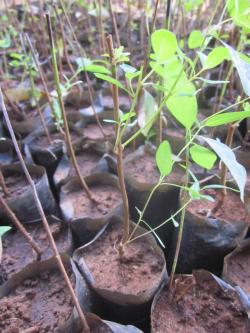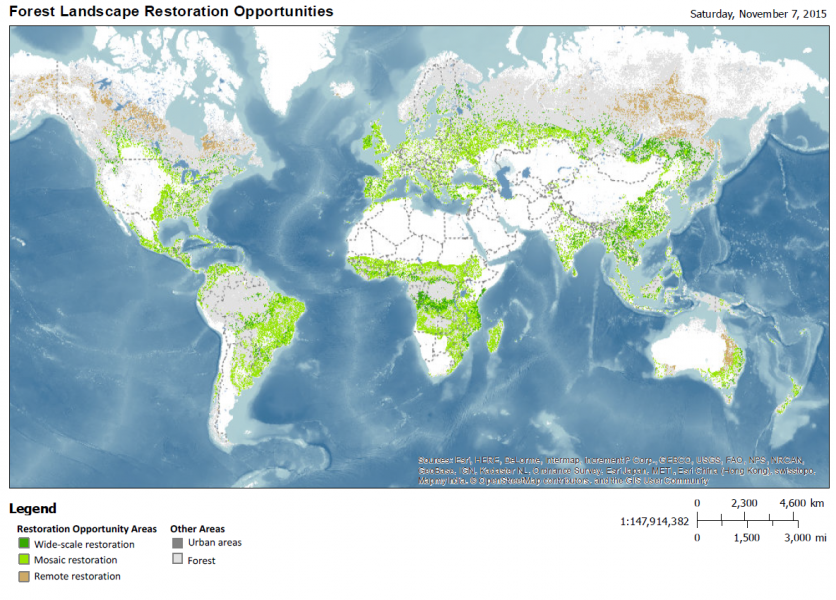Source: globalforestatlas.yale.edu
Published: March 28, 2017
In places where forests have been lost or degraded, restoration or reforestation projects may be undertaken in order to guarantee or accelerate the recovery of forests. Objectives of forest restoration can range from economic incentives, to social or cultural values, to ecosystem services, to biodiversity conservation. The task of forest restoration can be a complex one, however, involving diverse ecological and social systems, which are not always fully accounted for or understood.

In the broad sense of the term, forest restoration is not new. When changes in patterns of human settlements and livelihood practices result in agricultural fields being abandoned, those areas can often naturally re-establish as forest, as natural succession processes occur. Active forms of forest restoration or reforestation, where specific actions are taken to ensure or accelerate re-establishment of forest cover in an area, have been used for utilitarian purposes throughout history. Examples of these include loblolly pine planting in the United States, or secondary spruce forests in central Europe, under threats of timber scarcity or interest in “improving” nature and providing employment. Out of these earlier utilitarian reforestation efforts emerged more intentional ecologically-focused restoration efforts, aiming to restore habitat, biodiversity, or ecological function of degraded ecosystems.
Forest restoration has become an area of increasing interest and activity in recent years, ranging from small-scale efforts by NGO’s and communities to large-scale international commitments. One such example of a large-scale international commitment is the 20×20 (link is external) Initiative,(link is external) a country-led effort to restore 20 million hectares of land by 2020, in Latin America and the Caribbean. This effort is a part of the larger global (link is external) Bonn Challenge , a global initiative launched in 2011 aiming to restore 150 million hectares worldwide by 2020. Also in recent years there has been an increased focus on Landscape Scale Initiatives, which aim to incorporate trees in a multi-use mosaic of various land uses, and take into account multiple stakeholders, land-uses and scales for decision making and adaptive management, allowing for human livelihoods as well as ecological integrity and ecosystem services across a landscape. The World Resources Institute’s Global Restoration Initiative is home to “the Atlas of Forest and Landscape Restoration Opportunities,” an interactive map that classifies land around the world and their potential for different kinds of restoration. (Explore the atlas (link is external) here).
|
|
|
Figure 1: This image represents potential areas for different kinds of forest restoration around the world, based in information about forest cover over time, in addition to human population levels. From World Resource Institute’s “Atlas of Forest & Landscape Restoration Opportunities. See more at: http://www.wri.org/applications/maps/flr-atlas(link is external)/ |
Specific restoration practices range broadly, and can be quite complex due to diverse ecological contexts, socio-political settings, and stakeholder objectives. While restoration or reforestation can include the obvious action of tree planting, specific restoration actions can fall anywhere on a spectrum of intensity ranging from low-intensity actions , such as preventing disturbance (such as fire or grazing), to high-input or high-intensity actions such as soil amelioration, erosion control, weeding, herbicide application, among others.
GPFLR. (n.d.) Our Partners. Global Partnership on Forest and Landscape Restoration. Retrieved from http://www.forestlandscaperestoration.org/our-partners (link is external)
GPFLR. (n.d.) The Bonn Challenge. Global Partnership on Forest and Landscape Restoration. Retrieved from: http://www.forestlandscaperestoration.org/topic/bonn-challenge (link is external)
Stanturf, J.A. (2005). What is forest restoration? “Restoration of boreal and temperate forests.” CRC Press, Boca Raton, p. 3-11. http://www.srs.fs.usda.gov/pubs/ja/ja_stanturf022.pdf (link is external)
WRI. (n.d.) Initiative 20 x 20. World Resources Institute. Retrieved from: http://www.wri.org/our-work/project/initiative-20×20 (link is external)

